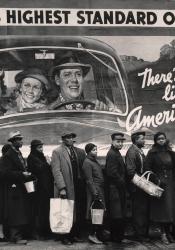The Great Depression Begins - 1929
The Great Depression is regarded as the most traumatic financial crisis the United States of America (USA) has ever faced. While it is commonly thought to have only affected the USA, it actually had drastic effects on European nations, too.
The Great Depression is formally regarded to have started in the fall of 1929, but the financial situations that caused the depression to occur started before that. The Great Depression was caused by “dislocated and dysfunctional financial markets, low interest rates, instability of the crisis epicenter, investors’ panic, and high bankruptcy rates,” which took years to develop (Nenovski and Pamukova 31).
The situation became particularly dire in August of 1929 when the USA entered a recession; however, the recession was seen as a typical, natural recession that properly reflected the ebb and flow of the economy. Ultimately, the cause of the recession—which was experienced globally and eventually developed into the Great Depression—was the manufacturing revolution; the Industrial Revolution prior to 1929 created what economists refer to as “a classic debt-deflation cycle” (Bruner and Miller 51).
Unfortunately, the federal government in the USA did not react to this recession correctly. Instead, they “increased the discount rate from 5% to 6%, a level not seen since the contraction in 1921,” to lessen the ongoing speculation about USA stock exchanges (Bruner and Miller 50). This was then mimicked by other countries striving to stabilize their economies, which caused the global Great Depression.
Arguably, however, what turned the recession into a full-blown depression was not even economics; fear may have been the underlying reason that the recession turned into a depression. More specifically, an unstable currency regime, poor federal response, banks panicking, and labor hoarding turned the recession into the Great Depression (Bruner and Miller 52). Citizens, the government, and banks were all terrified of the prospects and stopped trusting the stock market. This lack of trust caused the economy to crumble until it was stabilized in the spring of 1933.
Works Cited
Bruner, Robert F., and Scott C. Miller. “The Great Crash of 1929: A Look Back After 90 Years.” Journal of Applied Corporate Finance, vol. 31, no. 4, Fall 2019, pp. 43–58. EBSCOhost, doi:10.1111/jacf.12374.
Nenovski, Tome, and Nela Pamukova. “Roots, Causes, Effects, and Lessons Learned from the Global Financial Crisis.” Journal of Sustainable Development, vol. 9, no. 22, June 2019, pp. 18–33. EBSCOhost https://proxy.library.kent.edu/login?url=http://search.ebscohost.com/login.aspx?direct=tr ue&db=bth&AN=138553815&site=ehost-live
Further Information: Photo to Capture the Time and Short Video to Explain Why It Started
Bourke-White, Margaret. “World’s Highest Standard of Living.” The Guardian, 18 Sep. 2019, https://www.theguardian.com/artanddesign/2019/sep/18/great-depression-photography- art-exhibition-chicago.
“The Great Depression Explained in One Minute.” YouTube, uploaded by One Minute Economics, 18 April 2016, https://www.youtube.com/watch?v=Sv7IP2qL0gg.

